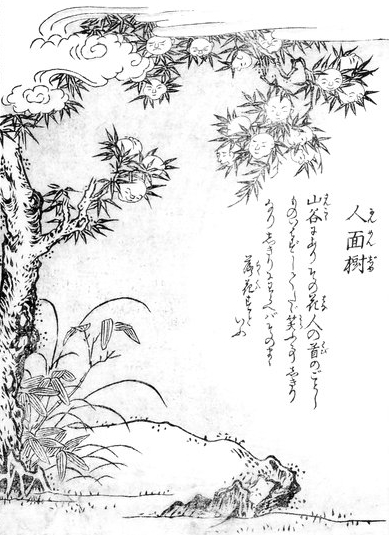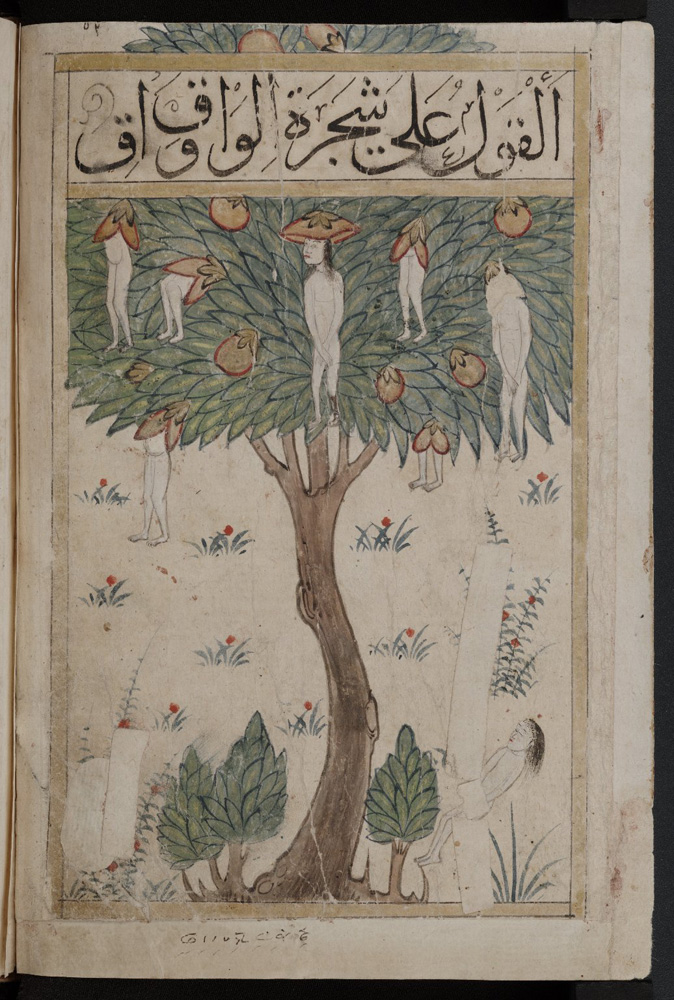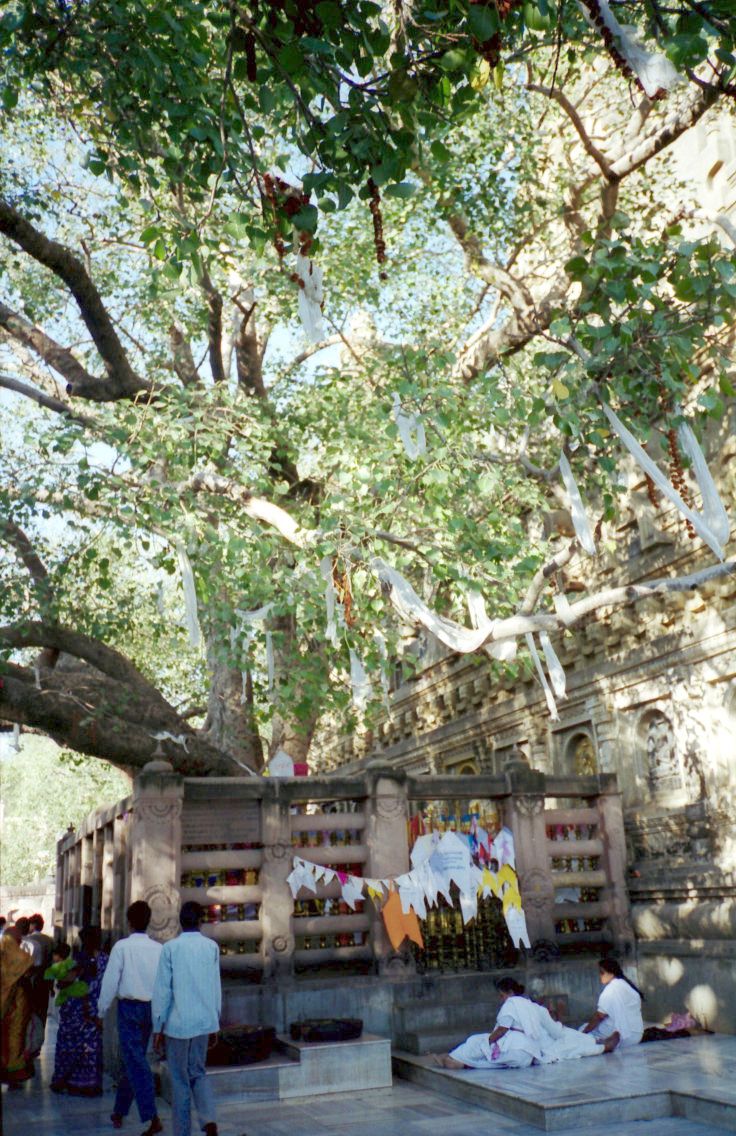|
Jinmenju
is a legendary Japanese tree in the Edo period ''Konjaku Hyakki Shūi'' by Toriyama Sekien. Concept The picture depicts it as a tree blooming flowers like human heads, with the following explanatory text: Besides Japanese yōkai, the ''Konjaku Hyakki Shūi'' also included publications of plants, animals and yōkai outside of Japan and this "jinmenju" as well as the ''Wakan Sansai Zue'' quote from the ''Sancai Tuhui'' and it depicts a tree from a land called "Daishikoku" (大食国, big-eat country). According to the ''Sancai Tuhui'', Daishikoku is a land thousand ri southwest, with flowers like human hands, and upon asking it questions, its flowers would laugh, but it wouldn't understand human language and if they laugh too much, the flowers would wither and fall. The ''Rōō Sawa'' (老媼茶話), a collection of strange tales from Aizu, also quotes the ''Sancai Tuhui'' while making statements about this tree. In popular culture The Pokémon Exeggutor is based on the jinmenj ... [...More Info...] [...Related Items...] OR: [Wikipedia] [Google] [Baidu] |
Wāḳwāḳ
Al-Wakwak ( ar, ٱلْوَاق وَاق '), also spelled al-Waq Waq, Wak al-Wak or just Wak Wak, is the name of an island, or possibly more than one island, in medieval Arabic geographical and imaginative literature. Identification with civilisations Wakwak is referred to in a number of sources; it is generally an island far away. In Arab versions, the famous island of Waq-Waq is located in the sea of China. The island is ruled by a queen and the population is only female: it is usually illustrated in al-Qazvini manuscripts of the Wonders of Creation showing the queen surrounded by her female attendants. Ibn Khordadbeh mentions Waqwaq twice: " East of China are the lands of Waqwaq, which are so rich in gold that the inhabitants make the chains for their dogs and the collars for their monkeys of this metal. They manufacture tunics woven with gold. Excellent ebony wood is found there. And again: Gold and ebony are exported from Waqwaq". [...More Info...] [...Related Items...] OR: [Wikipedia] [Google] [Baidu] |
Yaoguai
Yaoguai (妖怪 pinyin yāoguài) is a term for monsters or strange creatures. Yaogui (妖鬼 yāoguǐ, lit. "strange ghost"), yaomo (妖魔 yāomó, lit. "daemon") or yaojing (妖精 yāojīng, often translated as " sprite" or "faerie") are loosely related terms. Etymology Yaoguai (妖怪) is a compound word consisting of two Chinese characters. 妖 (yāo) is a noun meaning ''monster'' or ''demon''. 怪 (guài) means ''strange'' or ''unusual'' when used as an adjective, and ''monster'' or ''unusual creature'' as a noun. Each word individually signifies and connotes strangeness. Classical usages of both terms relate to preternatural phenomena and freakish occurrences where explanation fell outside the limited understanding of those observing them. These included freakish vegetation ("草妖"),eerie sounds ("鼓妖"),the unnatural onset of fog and darkness ("夜妖"),as well as a sudden loss in verbal fluency or inability to express oneself ("诗妖"). Yāo are blame ... [...More Info...] [...Related Items...] OR: [Wikipedia] [Google] [Baidu] |
Yōkai
are a class of supernatural entities and spirits in Japanese folklore. The word is composed of the kanji for "attractive; calamity" and "apparition; mystery; suspicious." are also referred to as , or . Despite often being translated as such, are not literally demons in the Western sense of the word, but are instead spirits and entities. Their behavior can range from malevolent or mischievous to benevolent to humans. often have animal features (such as the , depicted as appearing similar to a turtle, and the , commonly depicted with wings), but may also appear humanoid in appearance, such as the . Some resemble inanimate objects (such as the ), while others have no discernible shape. are typically described as having spiritual or supernatural abilities, with shapeshifting being the most common trait associated with them. that shapeshift are known as or . Japanese folklorists and historians explain as personifications of "supernatural or unaccountable phenomena to th ... [...More Info...] [...Related Items...] OR: [Wikipedia] [Google] [Baidu] |
Trees In Mythology
Trees are significant in many of the world's mythologies, and have been given deep and sacred meanings throughout the ages. Human beings, observing the growth and death of trees, and the annual death and revival of their foliage, have often seen them as powerful symbols of growth, death and rebirth. Evergreen trees, which largely stay green throughout these cycles, are sometimes considered symbols of the eternal, immortality or fertility. The image of the Tree of life or world tree occurs in many mythologies. Examples include the banyan and the sacred fig (''Ficus religiosa'') in Hinduism, Buddhism and Jainism, the tree of the knowledge of good and evil of Judaism and Christianity. In folk religion and folklore, trees are often said to be the homes of tree spirits. Germanic mythology as well as Celtic polytheism both appear to have involved cultic practice in sacred groves, especially grove of oak. The term ''druid'' itself possibly derives from the Celtic word for oak. The Egyp ... [...More Info...] [...Related Items...] OR: [Wikipedia] [Google] [Baidu] |
Mythological Human Hybrids
Myth is a folklore genre consisting of narratives that play a fundamental role in a society, such as foundational tales or origin myths. Since "myth" is widely used to imply that a story is not objectively true, the identification of a narrative as a myth can be highly controversial. Many adherents of religions view their own religions' stories as truth and so object to their characterization as myth, the way they see the stories of other religions. As such, some scholars label all religious narratives "myths" for practical reasons, such as to avoid depreciating any one tradition because cultures interpret each other differently relative to one another. Other scholars avoid using the term "myth" altogether and instead use different terms like "sacred history", "holy story", or simply "history" to avoid placing pejorative overtones on any sacred narrative. Myths are often endorsed by secular and religious authorities and are closely linked to religion or spirituality. Many soci ... [...More Info...] [...Related Items...] OR: [Wikipedia] [Google] [Baidu] |
Nariphon
The Nariphon ( th, นารีผล, from Pali ''nārīphala''), also known as Makkaliphon ( th, มักกะลีผล, from Pali ''makkaliphala''), is a tree in Buddhist mythology which bears fruit in the shape of young female creatures. The maidens grow attached by their head from the tree branches. This tree grows at the Himaphan, a mythical forest where the female fruits are enjoyed by the Gandharvas who cut the fruits and take them away. The Nariphon is also mentioned in the Vessantara Jātaka in which Indra placed these trees around the grove where the Bodhisattva Vessantara meditated. Myths and folklore According to Buddhist mythology, the god Indra created a pavilion (''Sala)'' as an abode for Vessantara, his wife, and two children to live. His wife went into the forest to collect fruits: she was, however, in danger of being attacked by hermits or yogis who lived in the forest. Although they had acquired special powers from their meditation, they had not conquered ... [...More Info...] [...Related Items...] OR: [Wikipedia] [Google] [Baidu] |
Aizu
is the westernmost of the three regions of Fukushima Prefecture, Japan, the other two regions being Nakadōri in the central area of the prefecture and Hamadōri in the east. As of October 1, 2010, it had a population of 291,838. The principal city of the area is Aizuwakamatsu. It was part of Mutsu Province; the area once was part of Iwase Province created during the reign of Empress Genshō.Meyners d'Estrey, Guillaume Henry Jean (1884). ; excerpt, '' Genshō crée sept provinces : Idzumi, Noto, Atoa, Iwaki, Iwase, Suwa et Sado en empiétant sur celles de Kawachi, Echizen, Etchū, Kazusa Province, Kazusa, Mutsu Province, Mutsu and Shinano Province, Shinano'' The ''Yōrō Ritsuryo'' established the Iwase Province in 718 through the division of the Michinoku Province (Mutsu Province). It was composed of five districts of Shirakawa (白河), Iwase (石背), Aizu (会津), Asaka (安積) and Shinobu (信夫). The area encompassed by the province reverted to Mutsu some ti ... [...More Info...] [...Related Items...] OR: [Wikipedia] [Google] [Baidu] |
Edo Period
The or is the period between 1603 and 1867 in the history of Japan, when Japan was under the rule of the Tokugawa shogunate and the country's 300 regional '' daimyo''. Emerging from the chaos of the Sengoku period, the Edo period was characterized by economic growth, strict social order, isolationist foreign policies, a stable population, perpetual peace, and popular enjoyment of arts and culture. The period derives its name from Edo (now Tokyo), where on March 24, 1603, the shogunate was officially established by Tokugawa Ieyasu. The period came to an end with the Meiji Restoration and the Boshin War, which restored imperial rule to Japan. Consolidation of the shogunate The Edo period or Tokugawa period is the period between 1603 and 1867 in the history of Japan, when Japan was under the rule of the Tokugawa shogunate and the country's regional '' daimyo''. A revolution took place from the time of the Kamakura shogunate, which existed with the Tennō's court, to the Tok ... [...More Info...] [...Related Items...] OR: [Wikipedia] [Google] [Baidu] |





